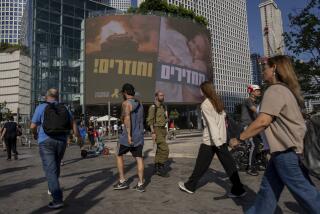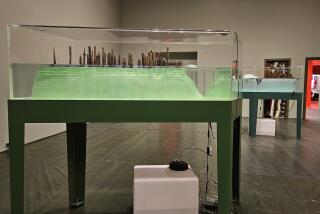Iraq’s blast walls reborn
- Share via
BAGHDAD — They are the sullen architecture of the “surge,” gray armies shrinking the horizon.
Baghdad is a city of blast walls, towering maze-like from the Tigris to the battered, seething neighborhoods of Shula and Sadr City. Concrete sentinels of last year’s troop buildup, they seal and sequester. They absorb explosions from car bombs, they bottle up bad guys.
The color of an angry sky, they aren’t so pretty, but painters dispatched by Baghdad University’s College of Fine Arts, commissioned by the government to decorate the walls, have in the last 20 months turned them into vast canvases for landscapes, portraits, abstracts, images from ancient Babylonia.
The wall on one street in Sadr City stretches nearly a mile. Motorcycle rickshaws zip past the paintings on each of its slabs: oases, mosques, women harvesting wheat, a hawk snatching a rabbit, all unraveling like scenes from an erratically edited film.
“We’re painting these walls not for ourselves, but for the Iraqi people,” said Asad Sagheer, an art teacher at the university who has infused walls with impressionism and historical realism. “We want to create a sense of beauty amid this violence. Every wall creates an internal feeling, the feeling of agony. So you have to create harmony over that agony with something you love.”
Drive across the city and the palette changes: sepia-toned kings of the past, the marshes of the south, the mountains of the north, the Tigris and Euphrates twisting between; and then, Caribbean-like colors rising from blowing garbage and dirt-bald lots: winged creatures, swans, peacocks, dolphins jumping.
The walls are quiet narratives looming over everyday life: Boys with plastic guns peek and play; girls rush to swing sets; black-draped women balance blocks of ice on their heads, water seeping and shining over their veils; and, just beyond, U.S. and Iraqi soldiers, with real guns, hunt insurgents and fuel their Humvees.
In his Karada neighborhood studio, Wisam Rahdi, a sleepy-eyed man with a loquacious manner, talked about walls he’s painted, but only after digressing into how he escaped Saddam Hussein’s army by fleeing to Malta and speaking of the girl who was shot in the leg because she loved him. They were romantic tales, stories for another day; this is a time of concrete barriers and new armies.
“Painting them is the only solution we have,” he said. “The simple Iraqi, he has no other options. He accepts everything. We are like those imprisoned in a big cage. Whatever the jailer gives him, he accepts. So we must accept the walls, but by painting them, I’m trying to beautify a small part of something for those living among them.”
The walls brought art and a new commerce to Sadr City. They have kept cars off certain roads, but the motorcycle rickshaws, carrying as many as six people, are permitted to drive along the walls between checkpoints.
“They’re trying to make them nice, but they’re walls, blocking things,” said Abu Baqr, sitting on his rickshaw. “We’re worried they’ll stay forever. If you paint them, it means they’ll stay. It’s better than looking at gray, but it means the same hurt.”
“You could paint them with real gold,” said another rickshaw driver, Ali Khudhuair, “but they’re still a tight collar suffocating us.”
Down the street and along another wall, flies hummed around Zahra Abed’s apples. She shooed them, but it did no good. Her fruit was rotting in her market stall. The walls were keeping shoppers out, and, as bad luck would have it, she has seven daughters, a dead husband and no sons to support her. She stood with her back to the wall, the crowd thinning, a few vendors left beneath the high sun.
“Business is down one-third because of the walls,” she said. “A few days ago I threw away $70 worth of fruit.”
What is the color of Iraq? Sand and bone, muted browns. Dust. Sagheer, the teacher of fine arts, said Iraq is shaped by desert storms and 120-degree heat, and the painter must not go for too much color for fear of losing the nation’s aesthetic. He said he is disturbed by what he sees painted on many blast walls.
“The proportion is wrong. The color palette is wrong. I consider this an insult,” he said. “It’s the work of lesser artists who are politically connected and given a wall to paint.”
Every wall for him is a chance to leave a legacy. Sagheer’s wall, near the French Cultural Center on the Tigris, runs along a military checkpoint and is painted with images from ancient Babylonia such as Nebuchadnezzar in his chariot. The colors are bled of vibrancy, as understated as parchment found in a chest buried in the sand.
“Images of Babylonia give us a feeling of our history and our patriotism,” he said. “The French Cultural Center is a foreign institution on our land, so I wanted them to see my civilization. My desire is to reflect my country’s heritage to foreigners and Iraqis. We need to show this is who we are.”
One day, when things are safer, the walls may be torn down and the internally demarcated city reconnected. This is already happening in a few parts of Baghdad; bullet-gouged slabs are lifted and hauled away. Most of the city is still shadowed, but if the surge keeps working, the art of war may be lost.
“Not all of it,” Sagheer said. “We hope to collect some of the walls and turn them into a maze for children. We don’t want to forget all that we’ve created.”
--
Times staff writers Raheem Salman, Saif Rasheed and Said Rifai contributed to this report.
More to Read
The biggest entertainment stories
Get our big stories about Hollywood, film, television, music, arts, culture and more right in your inbox as soon as they publish.
You may occasionally receive promotional content from the Los Angeles Times.











